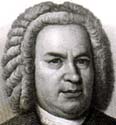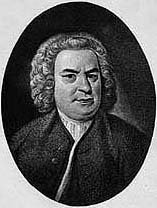The Present Day Misconceptions About Bach Performance Practice in the 19th Century - The Evidence of the
Recordings Pages at the Teri Noel Towe Home Pages - Page 1 - The Traditional View of Bach Performance Practice in
the Nineteenth Century
Johann Sebastian Bach
Present Day Misconceptions
About Bach Performance Practice in the Nineteenth
Century
The Evidence of the Recordings
This remarkable photograph is not a computer generated composite; the original of the Weydenhammer
Portrait Fragment, all that remains of the portrait of Johann Sebastian Bach that belonged to his pupil
Johann Christian Kittel, is resting gently on the surface of the original of the 1748 Elias Gottlob Haussmann
Portrait of Johann Sebastian Bach.

1748 Elias Gottlob Haussmann Portrait, Courtesy of William H. Scheide, Princeton, New Jersey
Weydenhammer Portrait Fragment, ca. 1733, Artist Unknown, Courtesy of the Weydenhammer Descendants
Photograph by Teri Noel Towe
©Teri Noel Towe, 2001, All Rights Reserved
PRESENT DAY MISCONCEPTIONS
ABOUT BACH PERFORMANCE PRACTICE IN THE NINETEENTH
CENTURY
THE EVIDENCE OF THE RECORDINGS [1]
Page 1
The Traditional View of Bach Performance Practice in the Nineteenth
Century
In his discussion of the activities of Felix Mendelssohn-Bartholdy's teacher, Carl Friedrich Zelter, who
championed the cause of Johann Sebastian Bach in Berlin at the beginning of the 19th century, Gerhard
Herz (1911-2000), made this observation in his doctoral dissertation, Johann Sebastian Bach in the Age
of Rationalism and Early Romanticism:
"Every one is steeped in his own time, and Zelter could not transcend the bounds of his
generation. For him, who was the great representative of the Berlin liederschule, Bach had to
be seen in this perspective; that is, he had to be modernized. Zelter revised Bach's church
compositions for himself alone, in the belief of serving Bach's cause thereby. In doing so, he
did not dispute the seriousness and profundity of Bach's perception. Only what was dated
was to be removed." [2]
In this connection, Professor Herz quotes a letter from the Thomascantor Moritz Hauptmann to the great
collector of Bach manuscripts, Franz Hauser:
"Through the orchestra, things have become dressed up too much, and the style of dress has
gone out of fashion." [3]
Herz's observations are as valid today as they were more than 60 years ago when they were first
published, but with a markedly different wrinkle that he, perhaps, did not anticipate. Everyone is steeped in
his own time, but I think it was George Santayana who once remarked that, "The twentieth century, like the
Hellenistic Age, will fall dead of exhaustion at the doors of libraries." We are obsessed in our time not with
the adaptation of worthy creations and ideas from the past for use by the modern age, but with the
preservation of the integrity of worthy creations and ideas from the past so that they can be passed on to
future generations, whole and unsullied by what we know are, or honestly believe to be, later accretions.
For the first time in the history of music, the performance practice applied to "old" compositions is not
the same as that applied to "newer" ones. No longer is it deemed appropriate to interpret virtually any
piece of "serious" music in one and the same "contemporary" performance style, as had been the case,
practically without exception, from Bach's own day (and before) until well into the present century. The
assumption, scarcely questioned until now, that old and new music were equally subject to the currently
prevailing interpretive fashions and standards, began to disintegrate rapidly in the 1920s, at precisely the
time when the schism between "serious" and "popular" music became complete and irrevocable. For the
first time, the prevailing performance practice for "serious" music -- dare I refer to it as "classical" music?
-- was not the natural response to, the inevitable outgrowth of, the demands and challenges put forth by
the composers of the day. No longer did the Gottfried Reiches, the Ignaz Schuppanzighs, the Ferdinand
Davids, and the Joseph Joachims influence and reshape the performance conventions of their times in
response or reaction to the demands of the Sebastian Bachs, the Beethovens, the
Mendelssohn-Bartholdys, and the Brahmses of their days. The determination and the establishment of the
customs of performance practice passed from the hands of the composers and the creative performers
into the hands of the academics and the recreative musicians, with results that run the gamut from the
praiseworthy to the reprehensible.
There is, of course, a formal "academic" tradition in music -- a venerable one that stretches back to Bach
and long before -- but the majority of those "academics" were also active performers, and, well into the
20th century, they maintained dichotomous presences as public performers and as teachers. To use
violinistic examples: Ferdinand David and Joseph Joachim simultaneously carried on careers as academics
and concert artists. Ivan Galamian and Dorothy DeLay have not. And the development of this separation
of functions parallels the development of the divergence between "serious" and "popular" music.
Chief among the failings of today's performers is the reality that far too much "old" music is played either
according to a bland, uniform "conservatory-ese" method that professional musicians learn in much the
same way that a professional journalist learns essential elements of style, or it is played according to a
uniform, reconstructed "authentic performance practice" that is considered standard for the period in
question, without regard to the subtle differences in regional performance customs, and all too often
without reference to the original performing materials.
To these sins of omission a further one must be added: Few professional musicians and musicologists
today are at all familiar with the history of the performance practice as it is preserved and documented on
recordings. Indeed, most assume that what knowledge and information is preserved in early recordings is
of little value to the study of performance practice, particularly that of earlier periods. It is my contention
that, in making these tacit and widely-held assumptions about recordings, music historians are overlooking
a source of invaluable evidence. For reasons that will soon be set forth, through careful study we can learn
far more than is supposed about the performing traditions held dear not only by those artists who made
records, but also by artists who flourished in pre-gramophonic periods as well.
But, just as the gramophone preserved, the gramophone destroyed. Recordings facilitated the blending of
national styles and traditions and thus their destruction. The watershed decade was the 1920s, when
numerous longstanding performance conventions, many of which can be traced back to the early
nineteenth century and before (the appoggiatura convention, for example) were discarded, often in the
name of a newly found interest in and devotion to composers' "intentions" and alleged faithfulness to their
"original" scores.
Those who summarily dismiss the evidence of early recordings implicitly assume that they reflect a
continuum of tradition dating only from the second half of the nineteenth century. That assumption, it
would appear, is cause enough to reject the testimony of these early discs as worthless and inappropriate
for the music of Bach. The primary problem with this notion is that it is based on the "evidence" of a few
late recordings -- almost always those of Wilhelm Furtwängler, Willem Mengelberg, and Leopold
Stokowski -- recordings that were made by artists who were strong personalities, iconoclastic and
single-minded recreative geniuses, whose work can hardly be said to represent the mainstream of
performance practice for their own, let alone earlier, times. Those who denigrate "early" recordings as a
mere reflection of mid- and late 19th century traditions, therefore, more often than not have no true
conception of what those traditions actually were.
Willem Mengelberg's legendary interpretation of the Saint Matthew Passion, BWV 244, recorded in
concert in the Concertgebouw in Amsterdam on Palm Sunday, 1939, [4] is a quintessential example of the
type of performance generally dismissed today as indicative of the 19th-century style. The opening
chorus, "Kommt ihr Töchter, helft mir klagen" is replete with grand ritards, neo-Mahlerian plasticity,
rubati within rubati and phrases within phrases, and a fastidious attention to details of dynamics within
phrases. The performance lasts 10 minutes 52 seconds. The overall tempo range is dotted quarter note =
31 to 36, with a range of dotted quarter note = 32 to 34 being the norm; the ritards, however, slow the
tempo to as low as dotted quarter note = 25 to 27. [5]
But is the Mengelberg interpretation, in fact, representative of the mainstream 19th-century approach?
Quite apart from the purely chronological objections to such a verdict, I maintain that Mengelberg's
intensely personal vision is the virtual antithesis of the mainstream 19th-century approach to Bach
interpretation.
Please click on  to advance to Page 2 - Siegfried Ochs and Hans Weisbach.
to advance to Page 2 - Siegfried Ochs and Hans Weisbach.
Click on  to return to the Johann Sebastian Bach Index Page.
to return to the Johann Sebastian Bach Index Page.
Click on the  to return to the Teri Noel Towe Welcome Page.
to return to the Teri Noel Towe Welcome Page.
teritowe@alumni.Princeton.EDU
Copyright, Teri Noel Towe, 1985, 1986, 1988, 1989, 2001
All Rights Reserved
The Present Day Misconceptions About Bach Performance Practice in the Nineteenth Century - The
Evidence of the Recordings Pages at the Teri Noel Towe Home Pages
are PPP Free web pages.

The Present Day Misconceptions About Bach Performance Practice in the Nineteenth Century - The
Evidence of the Recordings Pages at the Teri Noel Towe Home Pages have received
the HIP Woolly Mammoth Stamp of Approval from The HIP-ocrisy Home Page.